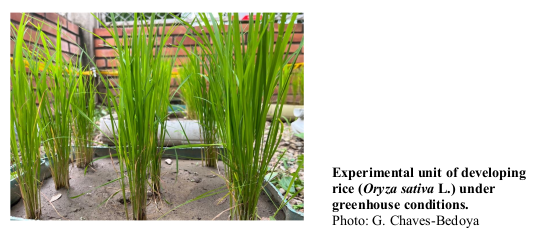Evaluación del control de Burkholderia glumae en el cultivo de arroz (Oryza sativa), FEDEARROZ 67, utilizando nanopartículas de plata (AgNPs) bajo condiciones de invernadero

Resumen
El tizón bacteriano de la panícula, causado por Burkholderia glumae, representa una amenaza significativa para la producción global de arroz, poniendo en peligro la seguridad alimentaria futura. La gravedad de esta enfermedad transmitida por semillas ha sido amplificada por las cambiantes condiciones ambientales, y aún no se han encontrado estrategias de control efectivas ni variedades de arroz completamente resistentes. Esta investigación se llevó a cabo con la variedad de arroz FEDEARROZ 67, originaria de Agua Clara, municipio de Cúcuta, y las pruebas se realizaron bajo condiciones controladas en invernadero en la Universidad Francisco de Paula Santander. Nuestro objetivo era evaluar el potencial de las nanopartículas de plata (AgNPs) sintetizadas electroquímicamente para controlar B. glumae. Empleamos un diseño completamente aleatorio con cinco tratamientos: preventivo, curativo, control positivo, control negativo y control absoluto. Las variables analizadas incluyeron el número de hojas cloróticas, la altura de la planta y el peso. Los análisis estadísticos comprendieron análisis de varianza y pruebas de comparación de medias de Tukey utilizando la versión 2018 de XLSTATS. Nuestros hallazgos revelaron que el tratamiento preventivo con AgNPs a una concentración de 5 ppm mostró efectos fitoprotectores significativos contra B. glumae. Las plantas bajo este tratamiento mostraron menos síntomas cloróticos y mayores alturas y pesos en comparación con los controles. Estos hallazgos resaltan el potencial de la nanotecnología como una herramienta innovadora para combatir enfermedades bacterianas en cultivos esenciales como el arroz, contribuyendo así a un futuro sostenible para la agricultura global.
Palabras clave
Tizón bacteriano de la panícula, Enfermedades en arroz, Control bacteriano, Transformación de plantas
Citas
- Abeer Mohammed, A.B., M.M. Abd Elhamid, M.K.M. Khalil, A.S. Ali, and R.N. Abbas. 2022. The potential activity of biosynthesized silver nanoparticles of Pseudomonas aeruginosa as an antibacterial agent against multidrug-resistant isolates from intensive care unit and anticancer agent. Environ. Sci. Eur. 34(1), 109. Doi: https://doi.org/10.1186/s12302-022-00684-2
- Ahmed, T., Z. Wu, H. Jiang, J. Luo, M. Noman, M. Shahid, I. Manzoor, K.S. Allemailem, F. Alrumaihi, and B. Li. 2021. Bioinspired green synthesis of zinc oxide nanoparticles from a native Bacillus cereus strain RNT6: characterization and antibacterial activity against rice panicle blight pathogens Burkholderia glumae and B. gladioli. Nanomaterials 11(4), 884. Doi: https://doi.org/10.3390/nano11040884
- Almeida, A.S., A.C. Junior, and J.L. Bentes. 2021. Synthesis of silver nanoparticles (AgNPs) by Fusarium concolor and inhibition of plant pathogens. Summa Phytopathol. 47(1), 9-15. Doi: https://doi.org/10.1590/0100-5405/235097
- Anees Ahmad, S., S. Sachi Das, A. Khatoon, M. Tahir Ansari, M. Afzal, M.S. Hasnain, and A.K. Nayak. 2020. Bactericidal activity of silver nanoparticles: a mechanistic review. Materials Sci. Energy Technol. 3, 756-769. Doi: https://doi.org/https://doi.org/10.1016/j.mset.2020.09.002
- Chaves-Bedoya, G., H.A. Padilla-Sierra, L. Ortiz-Rojas, and G. Peña-Rodriguez. 2022. Potential use of electrochemically synthesized silver nanoparticles on rice panicle blight pathogen, Burkholderia glumae. Rev. Colomb. Cienc. Hortic. 16(3), e141738. Doi: https://doi.org/10.17584/rcch.2022v16i3.14738
- Dakal, T.C., A. Kumar, R.S. Majumdar, and V. Yadav. 2016. Mechanistic basis of antimicrobial actions of silver nanoparticles. Front. Microbiol. 7, 1831. Doi: https://doi.org/10.3389/fmicb.2016.01831
- Ferdous, Z. and A. Nemmar. 2020. Health impact of silver nanoparticles: a review of the biodistribution and toxicity following various routes of exposure. Int. J. Mol. Sci. 21(7), 2375. Doi: https://doi.org/10.3390/ijms21072375
- Flórez, N.M.V. and D. Uribe. 2011. Determinación de la infección de Burkholderia glumae en semillas de variedades comerciales colombianas de arroz. Rev. Fac. Nac. Agr. Medellin, 64(2), 6093-6104.
- Gupta, N., C.P. Upadhyaya, A. Singh, K.A. Abd-Elsalam, and R. Prasad. 2018. Applications of silver nanoparticles in plant protection. pp. 247-265. In: Abd-Elsalam, K.A. and R. Prasad (eds.). Nanobiotechnology applications in plant protection. Nanotechnology in the Life Sciences. Springer, Cham, Switzerland. Doi: https://doi.org/10.1007/978-3-319-91161-8_9
- He, H.-M., L.-N. Liu, S. Munir, N.H. Bashir, Y. Wang, J. Yang, and C.-Y. Li. 2019. Crop diversity and pest management in sustainable agriculture. J. Integ. Agric. 18(9), 1945-1952. Doi: https://doi.org/https://doi.org/10.1016/S2095-3119(19)62689-4
- Jacoby, G.A. 2005. Mechanisms of resistance to quinolones. Clin. Infect. Dis. 41(Suppl. 2), 120-126. Doi: https://doi.org/10.1086/428052
- Khan, M., A.U. Khan, N. Bogdanchikova, and D. Garibo. 2021. Antibacterial and antifungal studies of biosynthesized silver nanoparticles against plant parasitic nematode Meloidogyne incognita, plant pathogens Ralstonia solanacearum and Fusarium oxysporum. Molecules 26(9), 2462. Doi: https://doi.org/10.3390/molecules26092462
- Khan, S., M. Zahoor, R. Sher Khan, M. Ikram, and N.U. Islam. 2023. The impact of silver nanoparticles on the growth of plants: The agriculture applications. Heliyon 9(6), e16928. Doi: https://doi.org/10.1016/j.heliyon.2023.e16928
- Kim, S.W., J.H. Jung, K. Lamsal, Y.S. Kim, J.S. Min, and Y.S. Lee. 2012. Antifungal effects of silver nanoparticles (AgNPs) against various plant pathogenic fungi. Mycobiology 40(1), 53-58. Doi: https://doi.org/10.5941/myco.2012.40.1.053
- Mansoor, S., I. Zahoor, T.R. Baba, S.A. Padder, Z.A. Bhat, A.M. Koul, and L. Jiang. 2021. Fabrication of silver nanoparticles against fungal pathogens. Front. Nanotechnol. 3, 679358. Doi: https://doi.org/10.3389/fnano.2021.679358
- More, P.R., S. Pandit, A. De Filippis, G. Franci, I. Mijakovic, and M. Galdiero. 2023. Silver nanoparticles: bactericidal and mechanistic approach against drug resistant pathogens. Microorganisms 11(2), 369. Doi: https://doi.org/10.3390/microorganisms11020369
- Ortega, L. and C.M. Rojas. 2021. Bacterial panicle blight and Burkholderia glumae: from pathogen biology to disease control. Phytopathology 111(5), 772-778. Doi: https://doi.org/10.1094/PHYTO-09-20-0401-RVW
- Pedraza, L.A., J. Bautista, and D. Uribe-Vélez. 2018. Seed-born Burkholderia glumae infects rice seedling and maintains bacterial population during vegetative and reproductive growth stage. Plant Pathol. J. 34(5), 393-402. Doi: https://doi.org/10.5423/ppj.Oa.02.2018.0030
- Sayler, R.J., R.D. Cartwright, and Y. Yang. 2006. Genetic characterization and real-time PCR detection of Burkholderia glumae, a newly emerging bacterial pathogen of rice in the United States. Plant Dis. 90(5), 603-610. Doi: https://doi.org/10.1094/pd-90-0603
- Wang, L.L., C. Hu, and L.Q. Shao. 2017. The antimicrobial activity of nanoparticles: present situation and prospects for the future. Int. J. Nanomed. 12, 1227-1249. Doi: https://doi.org/10.2147/IJN.S121956
- Yan, A. and Z. Chen. 2019. Impacts of silver nanoparticles on plants: a focus on the phytotoxicity and underlying mechanism. Int. J. Mol. Sci. 20(5), 1003. Doi: https://doi.org/10.3390/ijms20051003
- Zhou, X.-G. 2019. Sustainable strategies for managing bacterial panicle blight in rice. In: Jia, Y. (ed.). Protecting rice grains in the post-genomic era. IntechOpen. Doi: https://doi.org/10.5772/intechopen.84882
